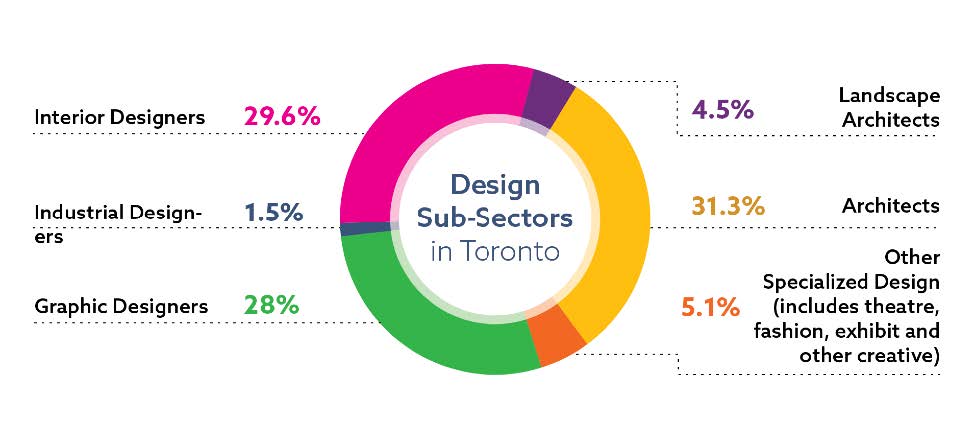


Umbra’s flagship concept store is in Toronto’s Queen West district. The Toronto-based home accessories design and manufacturing company has a global presence.
Harry Mahler • June 2025
One of the top design centres in the world, Toronto employs 24,700 designers who collectively earn $2.4B in annual wages. The diverse sector – made up of architects, landscape architects, graphic designers, fashion designers, and industrial and interior designers – has grown faster than its counterparts elsewhere in Ontario or Canada. (about 120K designers of all stripes are employed in Canada.)
Architects – 31.3%
Interior Designer – 29.6%
Graphic Designers – 28%
Landscape Architects – 4.5%
Industrial Designers – 1.5% or about 371 designers
Other Specialized Areas (includes theatre, fashion and exhibits) – 5.1%
Interior Designer – 29.6%
Graphic Designers – 28%
Industrial Designers – 1.5%

Toronto’s design sector is a significant contributor to the city’s creative economy and compares favourably with other major North American cities. Here’s an overview:
Size and Composition: Toronto’s design sector is diverse, encompassing graphic design, industrial design, fashion design, and digital media. It supports a robust network of creative industries with a mix of small independent studios, large firms, and international brands. The city’s multicultural character further enriches its design output.
Wages: In the Toronto region, wages for designers like graphic designers and illustrators range from CAD 20 to CAD 53.85 per hour, with a median of approximately CAD 34.87 per hour. These figures are competitive when compared to other North American cities, particularly given Toronto’s cost of living and the city’s role as a creative hub in Canada.
Annual Wages and Economic Contribution: Annual earnings for designers in Toronto are reflective of both entry-level roles and high-paying senior positions in established firms. These figures align well with those in U.S. cities like Chicago or New York, adjusted for currency differences. Additionally, Toronto’s design industry contributes significantly to the local economy by driving innovation and supporting adjacent sectors such as technology and advertising
Toronto offers a competitive and vibrant environment for designers, comparable to leading North American cities. This is bolstered by its cultural diversity, economic opportunities, and a strong focus on sustainable and innovative design practices.
Toronto stands out for its diverse and multicultural design ecosystem, with a significant concentration of design firms in sectors like technology, media, and entertainment. The city’s design workforce is notably younger compared to some other North American cities, with a median age of around 35.
The Toronto design sector has been growing at approximately 3-4% annually, with digital and technology-related design disciplines showing the most significant expansion.
Toronto has a robust and diverse design ecosystem, ranking among the top design hubs in North America. As of recent data, the city employs approximately 74,000 design professionals across various disciplines, including graphic design, industrial design, digital design, and architecture.
DesignTO: A Toronto-based non-profit organization hosting the annual DesignTO Festival, showcasing innovative design practices with a focus on sustainability, social justice, and creativity. It aims to highlight the transformative potential of design.
Canadian Design Network (CDN): A newly launched platform focused on fostering collaboration among designers across disciplines. CDN supports Canadian designers by providing resources, news, design competitions, and events to celebrate innovation and tackle societal challenges.
Canadian Design Resource (CDR): An online platform celebrating Canadian design across various fields, including industrial, graphic, and architectural design.
Design Exchange (DX): Based in Toronto, DX is Canada’s design museum, promoting design education and innovation while highlighting diverse disciplines, from industrial to fashion design.
Design Industry Advisory Committee: A research-based think tank established by the City of Toronto in 2001, the Design Industry Advisory Committee works with all levels of government to deliver sector-wide advocacy and support.
These organizations showcase the vibrant and diverse design landscape in Toronto and Canada, offering resources, advocacy, and opportunities for designers across all disciplines.
www.toronto.ca/explore-enjoy/visitor-toronto/shop-toronto-design
About Harry Mahler
Harry Mahler is a retired design educator, practicing designer, and founder of the Canadian Design Network. With years of experience in teaching and design, he now focuses on supporting and celebrating Canada’s design community through CDN.